Kung pao chicken or gong bao ji ding (宫保鸡丁) is a popular Chinese-takeout dish made with juicy diced chicken, diced vegetables, and roasted peanuts, stir fried with a savory, slightly sweet, and spicy brown sauce. This better-than-takeout version can be easily made at home and is perfect with a side of egg fried rice or shrimp fried rice!

Kung pao chicken is savory, slightly sweet, and usually mildly spicy. It's a popular chinese takeout dish loaded with small pieces of diced chicken, diced vegetables like bell peppers, onions, bamboo shoots, and sometimes celery and carrots. But what most people remember about the dish are the peanuts!
Believe it or not, every bite of kung pao chicken with peanuts tastes totally different, in a great way!
If you're looking for more easy Chinese takeout recipes, check out our 10-minute egg drop soup, sesame chicken, shrimp lo mein, and beef and broccoli!
Jump to:
Quick history
Did you know that kung pao chicken in Chinese is gōng bǎo jī dīng (宫保鸡丁)? It literally translates to the "palace guardian's diced chicken".
The dish is believed to have been named after Ding Baozhen, a Qing Dynasty official and governor of Sichuan province. "Gong bao" (aka palace guardian) was his title and "ding" was a play on his surname that also describes a style of knife cut. In Chinese, "ding" (丁)describes anything that's diced or cut into cubes.

Ingredients
Please scroll down to the recipe card for the ingredient quantities!
For marinating the chicken:
- Chicken thighs - We recommend chicken thighs because dark meat is always juicier and has more flavor than white meat. However, you can make kung pao chicken with chicken breast as well.
- Egg white - The egg white is part of the velveting process to protect the chicken and keep it juicy.
- Shaoxing cooking wine - This Chinese pantry classic makes the chicken more fragrant and gets rid of any unwanted chicken taste. Although Shaoxing rice wine is optional, we highly recommend it!
- Salt - To season the chicken.
- Cornstarch - The binder for the velveting process. The cornstarch creates the coating around the chicken.
- Oil - Just a little oil in the marinate helps to make the chicken easier to separate when frying. Any neutral oil is fine. Also, some oil will be used for frying.
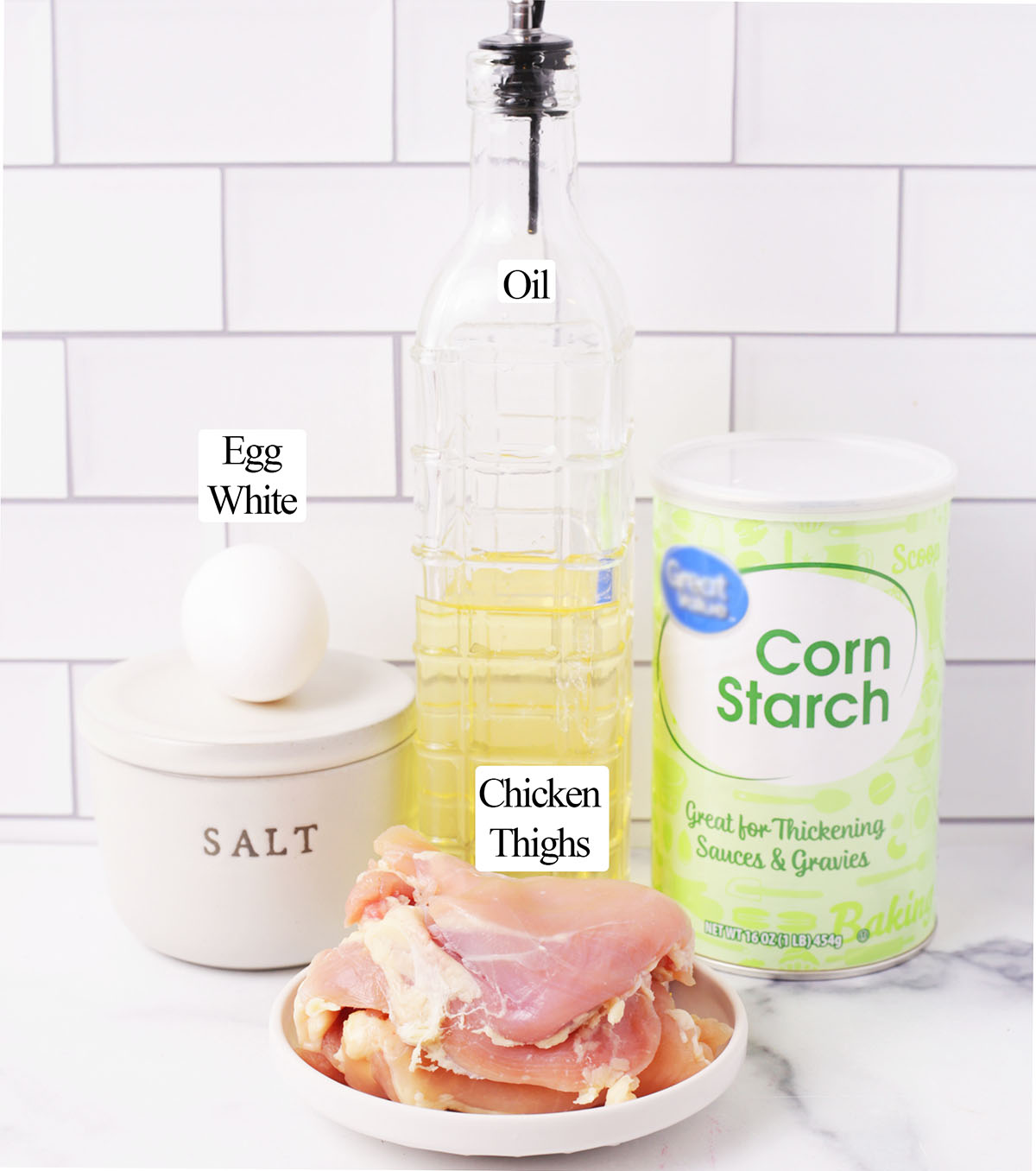
Kung pao sauce:
- Soy sauce - The majority of the sauce. We used light sodium soy sauce. If you are using regular soy sauce, you may want to use a little less and supplement with some water.
- Hoisin sauce - It adds a mild sweetness and a distinctive flavor to the kung pao sauce.
- Water - To dilute the sauce.
- Sugar - Regular granulated sugar is fine.
- Cornstarch - A little bit of cornstarch is needed to help thicken the sauce. If you prefer the sauce to be thicker, you can use an additional teaspoon or two.
- Dark soy sauce - Mostly to give the kung pao sauce a darker color. If you don't mind a lighter color, you can omit the dark soy sauce.
- Vinegar - Regular white distilled vinegar is perfect for the sauce. Just a small amount is added to give the sauce a subtle brightness while adding some gloss to the sauce.
- Sesame oil (optional) - To finish the dish and to make the dish more fragrant.

The rest of the dish:
- Yellow onion and green onion - Because onion makes everything more fragrant! Plus, they add texture and color to the kung pao chicken. For the green onion, you can split the white parts so that they cook faster.
- Bell pepper - You can use either green or red bell pepper, or both. They add great texture and color. If you prefer, you can also use celery instead. Just small dice them.
- Bamboo shoot - They add a very particular flavor to kung pao chicken but can be an acquired taste. We highly recommend giving bamboo shoots a try, at least for the first time. make sure to get the whole or halved bamboo shoots in brine water, NOT the slices or strips.
- Ginger and garlic - They make everything more aromatic and makes the sauce more flavorful.
- Peanuts - You can't have kung pao chicken without some peanuts! Chinese takeout versions simply garnish kung pao chicken with some roasted peanuts. If you prefer, roast or fry your own using raw, skinless peanuts, like the classic way.
- Ground chili pepper - To add some spice to the dish. You can also just finish the dish with some homemade chili oil too!

How to make kung pao chicken
Marinate the chicken:
1. In a large mixing bowl, add the diced chicken, the egg white, shaoxing rice wine, and salt. Mix vigorously until the liquid is mostly absorbed.


2. Next, add the cornstarch and mix all the chicken is evenly coated. Finish by adding the oil and mix until well combined. Set aside as you prepare everything else and let the chicken marinate for 5 to 10 minutes or overnight.

Prepare the sauce:
In a bowl or measuring cup, combine the soy sauce, hoisin, water, sugar, vinegar, dark soy sauce, cornstarch, and sesame oil. Mix until well combined and set aside.
💡 Tip: If you prefer a thicker sauce, use an additional 1 to 2 teaspoons of cornstarch.
Make the kung pao chicken:
1. In a wok or sauté pan, add about ¼ inch to ½ inch of oil. Heat the oil to 350°F and maintain the heat.
🌟 Pro tip: If you don't have a thermometer, you can check the oil temperature using a wooden chopstick! Stick the tip of the chopstick in the oil and if it sizzles, it's ready.

2. Once the oil is hot, add the marinated chicken pieces into the oil and fry for about 5 minutes, or until the chicken is cooked and turns kind of golden. While the chicken pieces are frying, use a spoon or a pair of tongs to break up the chicken and turn them occasionally. When the chicken is cooked, remove from the pan and let it drain on some paper towel.
📝 Note: Make sure to not overcrowd the pan so the oil temperature doesn't drop drastically! Fry in batches if needed.
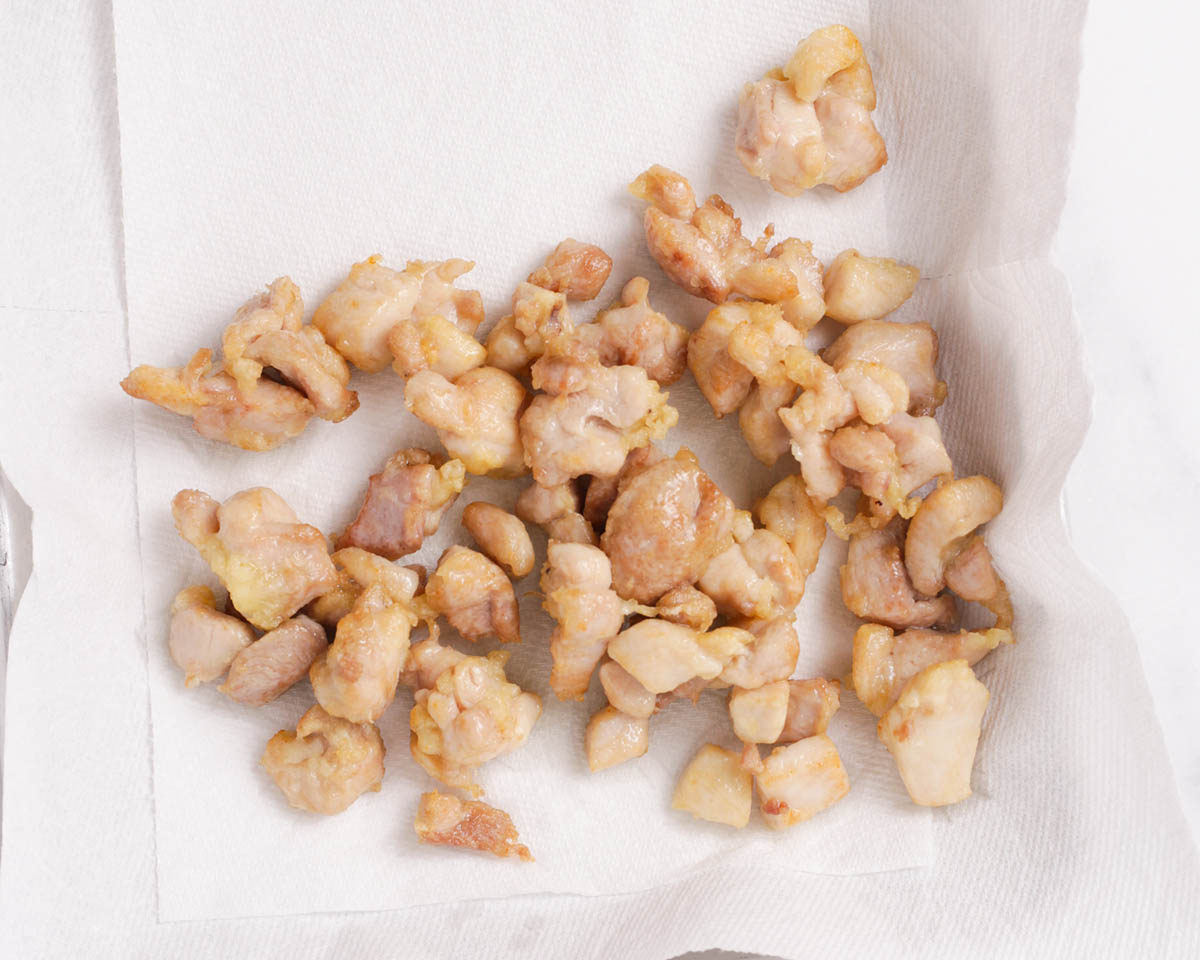
3. Drain most of the oil from the wok or pan, leaving about 2 to 3 tablespoons. Heat the oil over medium high heat.
🚨 Caution! *If you are uncomfortable with handling the leftover hot oil, use a new pan! Safety comes first!*
4. When the oil is hot, add the minced garlic, ginger, ground and whole chili peppers. Stir fry until fragrant.

5. Add the onion, bell pepper, bamboo shoots and the white parts of the green onion. Stir fry for about 30 seconds to a minute, until the vegetables are warmed through. Add the fried chicken pieces, roasted peanuts, and green parts of the green onion. Stir fry briefly until evenly combined.
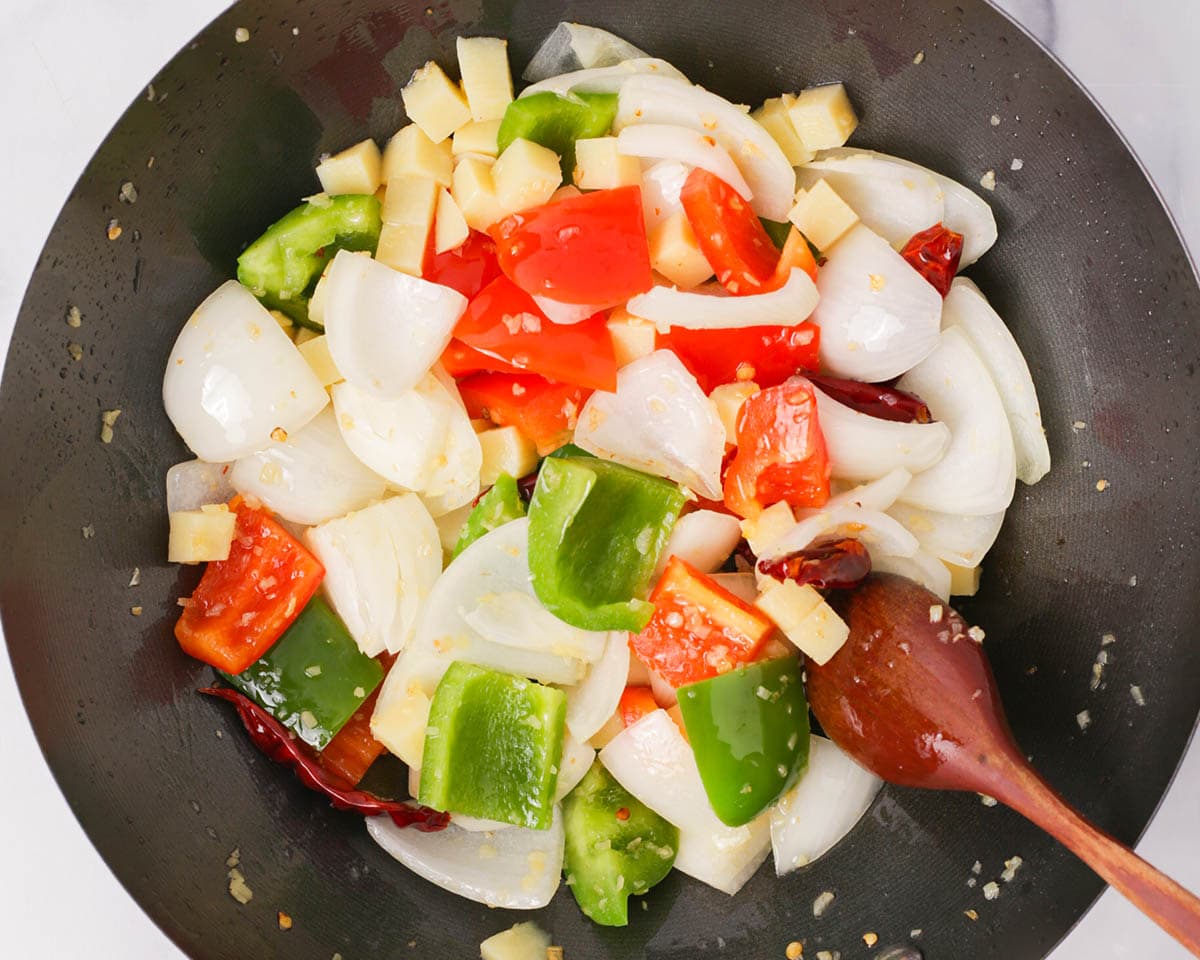

6. Give the prepared sauce a mix and pour it around the wok. Let the sauce simmer for a few seconds until it starts to thicken. Reduce the heat to low and toss the kung pao chicken until everything is evenly coated.

7. Serve the kung pao chicken with white or fried rice and garnish with more roasted peanuts. Enjoy!

How to roast peanuts
To roast raw, shelled peanuts in the oven, place the peanuts on a sheet pan and drizzle with a small amount of oil. Mix to coat the peanuts evenly, then flatten them into a single layer. Roast them in the oven at 350°F for about 15 minutes or until they turn golden or golden brown.
If you want a faster way to have the peanuts ready, fry them in a some oil! Heat a wok or pan over medium heat, with about ¼ inch of oil and. Once the oil is hot, about 350°F, add the peanuts and let them slowly fry for about 5 minutes or until the peanuts turn golden and smells fragrant. Make sure to stir frequently to prevent uneven cooking. Also, note that when adding the peanuts, the oil should start sizzling shortly. If not, the oil is probably not hot enough.


Recipe tips
- Keep the chicken pieces smaller than ½ inch thick! If the chicken pieces are too big, it will take longer to cook and may result in dry chicken.
- Try to maintain the oil temperature around 350°F. Low oil temperature will result in greasy chicken that may also be undercooked. If the oil temperature is too high, the outside can brown and overcook, making the chicken dry.
- Feel free to swap, add, and omit the vegetables to your preference! But make sure to not overcook the vegetables so that they don't lose their texture and refreshing flavors.
Storage and reheating
To store leftover kung pao chicken, let it cool completely before storing in an airtight container. Keep it refrigerated and it will last for up to 3 to 4 days. You can reheat the leftover in the microwave until heated through or on the stovetop, in a pan.
To reheat on the stovetop, heat a nonstick pan over medium to medium high heat. Stir fry until the chicken and vegetables are completely hot.

FAQ
Yes, absolutely! We opted for chicken thighs because dark meat is juicier and has more flavor, but feel free to substitute for chicken breasts if you prefer. Prepare the chicken breast the same as as the thighs.
Kung pao chicken and General Tso's chicken are completely different dishes. The only thing in common is that the chicken pieces are fried. Takeout style kung pao chicken uses small pieces diced chicken, stir fried with vegetables, peanuts, and a savory, slight sweet, and mildly spicy brown sauce.
On the other hand, General Tso's chicken is made with larger pieces of fried chicken and is tossed in a sweet, tangy, and spicy red sauce. Not vegetables and no peanuts involved.
Yes! Kung pao chicken is savory, slightly sweet, and mildly spicy. You can freely adjust the level of heat by adjusting the amount of pepper used.
Peanuts are a signature ingredient in kung pao chicken, so we highly recommend adding some if you are not allergic. Believe it or not, the peanuts actually enhances the flavor of the dish.
If you’ve made this recipe or any recipes from our blog, please tag us on Instagram using #twoplaidaprons! You can also tag us in your Instagram stories using @two_plaid_aprons. We would love to see your creations! It absolutely makes our day! 🥰
📖 Recipe
Kung Pao Chicken (Gong Bao Ji Ding)
Ingredients
For the chicken:
- 2 pounds boneless, skinless chicken thighs cut into no larger than ½ inch dices (about 5 to 6 thighs)
- 1 large egg white
- 1 tablespoon Shaoxing rice wine (optional)
- ½ teaspoon salt
- 2 tablespoons cornstarch
- 1 tablespoon oil any neutral oil
For the kung pao sauce:
- 3 tablespoons soy sauce light sodium
- 3 tablespoons hoisin sauce
- 2 tablespoons water
- 1 tablespoon white vinegar
- 1 tablespoon granulated sugar
- 1 teaspoon dark soy sauce
- 1½ teaspoons cornstarch
- 1 teaspoon sesame oil (optional)
For the rest of the dish:
- 1 small yellow onion large dice
- 1 bell pepper large dice (green, red, or both)
- 2.5 ounces bamboo shoots small diced
- 3 stalks green onion cut into 1 inch pieces (whites and greens separated)
- 1 tablespoon garlic minced (about 2 to 3 cloves)
- 1 tablespoon ginger peeled and minced (about an inch knob)
- 1 teaspoon Chinese chili pepper flakes more or less to your preference
- ⅓ cup roasted peanuts more or less to your preference (plus more for garnish)
- Whole dry chili pepper optional for garnish
- Oil for cooking
Instructions
Marinate the chicken:
- In a large mixing bowl, add the diced chicken, the egg white, shaoxing rice wine, and salt. Mix vigorously until the liquid is mostly absorbed.
- Next, add the cornstarch and mix until all the chicken is evenly coated. Finish by adding the oil and mix until well combined. Set aside as you prepare everything else and let the chicken marinate for 5 to 10 minutes or overnight.
Prepare the kung pao sauce:
- In a bowl or measuring cup, combine all the ingredients for the kung pao sauce (soy sauce, hoisin, water, sugar, vinegar, dark soy sauce, cornstarch, and sesame oil). Mix until well combined and set aside.*If you prefer a thicker sauce, use an additional 1 to 2 teaspoons of cornstarch.*
Make the kung pao chicken:
- In a wok or sauté pan, add about ¼ inch to ½ inch of oil. Heat the oil to 350°F and maintain the heat.
- Once the oil is hot, add the marinated chicken pieces into the oil and fry for about 5 minutes, or until the chicken is cooked and turns kind of golden. While the chicken pieces are frying, use a spoon or a pair of tongs to break up the chicken. When the chicken is cooked, remove from the pan and let it drain on some paper towel.*Make sure to not overcrowd the pan so the oil temperature doesn't drop drastically! Fry in batches if needed.*
- Drain most of the oil from the wok or pan, leaving about 2 to 3 tablespoons. Heat the oil over medium high heat.*If you are uncomfortable with handling the leftover hot oil, use a new pan! Safety comes first!*
- When the oil is hot, add the minced garlic, ginger, ground and whole chili peppers. Stir fry until fragrant.
- Add the onion, bell pepper, bamboo shoots and the white parts of the green onion. Stir fry for about 30 seconds to a minute, until the vegetables are warmed through. Add the fried chicken pieces, roasted peanuts, and green parts of the green onion. Stir fry briefly until evenly combined.
- Give the prepared sauce a mix and pour it around the wok. Let the sauce simmer for a few seconds, until it starts to thicken. Toss the kung pao chicken until everything is evenly coated.
- Serve the kung pao chicken with white or fried rice and garnish with more roasted peanuts. Enjoy!
Notes
- Chicken - We opted for chicken thighs because they are the juiciest and most flavorful. If you prefer, you can also use chicken breast.
- Size - It is very important that the chicken, whether you use thighs or breasts, is cut into small dices no larger than ½ inch. If the chicken pieces are too big, they'll take more time to cook, which can make them dry. They'll also take a longer time to properly marinate.
- Chili pepper - Did you know that you can skip chili pepper and use chili oil for the spice? If you don't have chili pepper on hand, simply skip it and just drizzle your desired amount of chili oil on the kung pao chicken and give it a few tosses to evenly distribute.




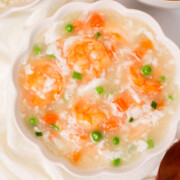



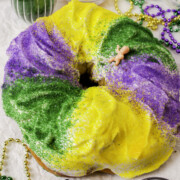


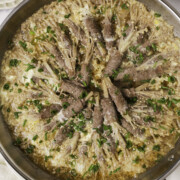








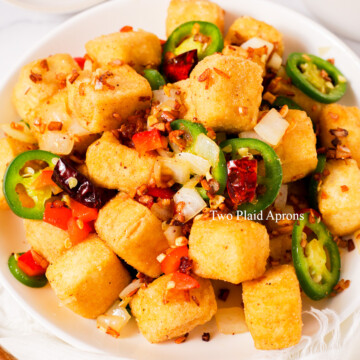

Comments
No Comments